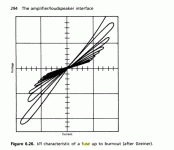bear said:I think I mentioned this some time back, but iirc, Borwick in his book on headphones and speakers has a very clearly written and detailed chapter on the non-linear effects of fuses.
_-_-bear
Mr. Curl, you can email me that tanh paper... tnx.
I usually remove all fuses, but for different reasons. Note: I do not like to listen to music loud and never have had an incident due to a lack of fuse.
But on their non-linearities, yes, they are easily derived. Like most non-linear resistances one would be hard pressed to argue for any effects that were not low order, symmetrical, and most important at an appreciable fraction of their rated use. Most importantly like things analog the effects monotonically decrease with level.
Borwick in his book on headphones and speakers has a very clearly written and detailed chapter on the non-linear effects of fuses
http://books.google.com/books?id=pA...k9WqBg&sa=X&oi=book_result&ct=result&resnum=5
Attachments
Dimitri this plot is unscaled. In general without scales this data is not useful. You can show non-linearity of RN60 resistors at -130dB and blow it up to fill the screen.
Put a fuse in series with a speaker and then replace it with a resistance and look at the difference. Hard since fuses are tiny fractional Ohms. OTOH a four wire measurement on a fuse is easy to do with a good instrumentation amplifier.
Put a fuse in series with a speaker and then replace it with a resistance and look at the difference. Hard since fuses are tiny fractional Ohms. OTOH a four wire measurement on a fuse is easy to do with a good instrumentation amplifier.
john curl said:Not peer reviewed, either.
One of your favorite guys, Doug (5534) Self, has this stuff included in his book with real scaled measurements. Of course he recommends the liberal application of feedback. Doug shows the problem mainly at low freqencies (the looping) and at near failure point.
is this the DR- Greiner paper you refer to, John:
AES E-Library
Transconductance Power Amplifier Systems for Current-Driven Loudspeakers
JAES Volume 37 Issue 10 pp. 809-822; October 1989
or maybe this is it:
AES E-Library
Amplifier-Loudspeaker Interfacing
JAES Volume 28 Issue 5 pp. 310-315; May 1980
AES E-Library
Transconductance Power Amplifier Systems for Current-Driven Loudspeakers
JAES Volume 37 Issue 10 pp. 809-822; October 1989
or maybe this is it:
AES E-Library
Amplifier-Loudspeaker Interfacing
JAES Volume 28 Issue 5 pp. 310-315; May 1980
I think this is the right one.
Amplifier-Loudspeaker Interfacing
JAES Volume 28 Issue 5 pp. 310-315; May 1980
Loudspeaker cables are investigated to determine if they exhibit transmission-line characteristics. Lumped representations of cables are suggested with consideration of the effects cable parameters might have on the audio signal being transmitted. Interaction of the cable with the amplifier, the loudspeaker, and other elements which may be part of the amplifier-cable-loudspeaker circuit are treated.
Author: Greiner, Richard A.
Affiliation: Department of Electrical Engineering, University of Wisconsin, Madison, WI,
Amplifier-Loudspeaker Interfacing
JAES Volume 28 Issue 5 pp. 310-315; May 1980
Loudspeaker cables are investigated to determine if they exhibit transmission-line characteristics. Lumped representations of cables are suggested with consideration of the effects cable parameters might have on the audio signal being transmitted. Interaction of the cable with the amplifier, the loudspeaker, and other elements which may be part of the amplifier-cable-loudspeaker circuit are treated.
Author: Greiner, Richard A.
Affiliation: Department of Electrical Engineering, University of Wisconsin, Madison, WI,
Another paper published 1991
by
can be free of charge for anyone be downloaded
from Bruce Coppola website, here
Effects of Cable, Loudspeaker and Amplifier Interactions
Fred E. Davis 1991 June in a magazine
http://bruce.coppola.name/audio/cableInteractions.pdf
by
can be free of charge for anyone be downloaded
from Bruce Coppola website, here
Effects of Cable, Loudspeaker and Amplifier Interactions
Fred E. Davis 1991 June in a magazine
http://bruce.coppola.name/audio/cableInteractions.pdf
10 REFERENCES
[1] R. A. Greiner, "Amplifier-Loudspeaker Interfacing," J. Audio Eng. Soc., vol. 28, pp. 310-315
The Author:
Fred E. Davis is currently a consulting electronics controls, portable instrumentation and tools, computer
engineer, and previously has been director of engi- hardware design and software, and consumer elecneering
for machine vision and optical data storage tronics. Besides a passion for music, his interests incompanies.
He has worked with biomedical electronics, clude photography, books
Nothing has changed....................the moderators shoud split this into two threads. .
http://www.toonio.com/v/10929/two-frogs-food-fight.html
Jam
http://www.toonio.com/v/10929/two-frogs-food-fight.html
Jam
scott wurcer said:I think this is the right one.
Amplifier-Loudspeaker Interfacing
JAES Volume 28 Issue 5 pp. 310-315; May 1980
Loudspeaker cables are investigated to determine if they exhibit transmission-line characteristics. Lumped representations of cables are suggested with consideration of the effects cable parameters might have on the audio signal being transmitted. Interaction of the cable with the amplifier, the loudspeaker, and other elements which may be part of the amplifier-cable-loudspeaker circuit are treated.
Author: Greiner, Richard A.
Affiliation: Department of Electrical Engineering, University of Wisconsin, Madison, WI,
How many kilometers of cable did he investigate?
What's wrong? Lineup posted a paper that concludes that #12 zip cord is totally adequate in many applications. Furthermore the article relies almost completely on concrete actual measurements.
Note to moderators don't act on my account I will start my own threads. Hey Jam, no flies on me.
Note to moderators don't act on my account I will start my own threads. Hey Jam, no flies on me.
nicoch46 said:HI PMA , the thick Blowtorch alu box isn't for RF ??
Box is quite fine. But connectors are insulated from the box. Electric field component gets easilly inside the box along the wires. Then you have bare wires inside. If I made a similar measurement as I have shown here, on Blowtorch, I would get poor result, speaking in RF terms.
- Status
- Not open for further replies.
- Home
- Amplifiers
- Solid State
- John Curl's Blowtorch preamplifier
